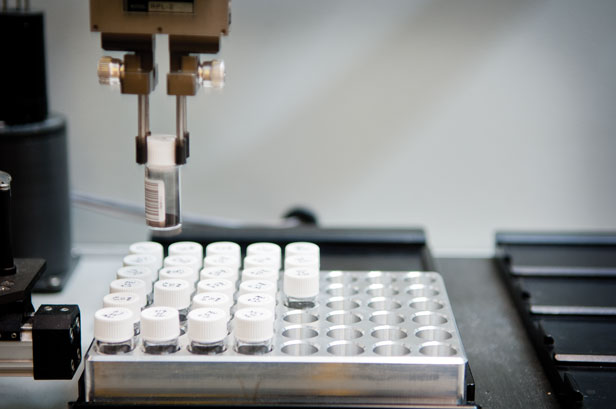High-Speed Materials Discovery
Electric cars could travel farther, and smart phones could have more powerful processors and better, brighter screens, thanks to batteries based on new materials being developed by San Diego–based Wildcat Discovery Technologies.
The company is accelerating the identification of valuable energy storage materials by testing thousands of substances at a time. In March of last year, it announced a lithium cobalt phosphate cathode that boosts energy density by nearly a third over current cathodes in popular lithium-ion phosphate batteries. The company also unveiled an electrolyte additive that allows batteries to work more reliably at higher voltages.

2/ Here, some precursor materials have been refined into powder suitable for making battery electrodes.
Choosing the optimal materials for batteries is a particularly tricky problem. The devices have three principal components: an anode, a cathode, and an electrolyte. Not only can each be formed from almost any blend of a huge number of compounds, but the three components have to work well together. That leaves many millions of promising combinations to explore.

3/ Cathodes, anodes, and electrolytes are assembled into small working batteries, which are tested by the thousand in this tower. Testing materials together allows dud combinations to be eliminated quickly.
To hunt down winning combinations, Wildcat has adopted a strategy originally developed by drug discovery labs: high-throughput combinatorial chemistry. Instead of testing one material at a time, Wildcat methodically runs through thousands of tests in parallel, synthesizing and testing some 3,000 new material combinations a week. “We’ve got materials in the pipeline that could triple energy density,” says CEO Mark Gresser.
Others have tried the combinatorial technique to find new battery materials, but they’ve run into a stumbling block. The easy way to test thousands of materials is to deposit a sample of each one in a thin film atop a substrate. This approach did allow previous researchers to turn up promising materials for battery components—but then candidates would typically prove unsuited to cost-effective large-scale production processes.

To process so many samples, Wildcat relies heavily on automation. This assay machine weighs and records vials of materials.
To avoid that time-wasting detour, Wildcat found ways to produce samples using miniaturized versions of large-scale production techniques. In effect, the candidate materials are being tested for ease of manufacturing at the same time as they’re being tested for performance. Wildcat also tests the materials wired together as actual batteries, and in a variety of potential operating conditions. “There are a lot of variables that affect battery performance, including temperature and voltage, and we examine all of them,” says Gresser. The result is that a material that performs well in a Wildcat test bed will probably perform well in field tests.
If Wildcat is successful, its efforts could lead to batteries that are smaller or more powerful than their present-day counterparts—improvements that will appeal to the makers of smart phones and electric vehicles alike.
Keep Reading
Most Popular
Large language models can do jaw-dropping things. But nobody knows exactly why.
And that's a problem. Figuring it out is one of the biggest scientific puzzles of our time and a crucial step towards controlling more powerful future models.
The problem with plug-in hybrids? Their drivers.
Plug-in hybrids are often sold as a transition to EVs, but new data from Europe shows we’re still underestimating the emissions they produce.
Google DeepMind’s new generative model makes Super Mario–like games from scratch
Genie learns how to control games by watching hours and hours of video. It could help train next-gen robots too.
How scientists traced a mysterious covid case back to six toilets
When wastewater surveillance turns into a hunt for a single infected individual, the ethics get tricky.
Stay connected
Get the latest updates from
MIT Technology Review
Discover special offers, top stories, upcoming events, and more.